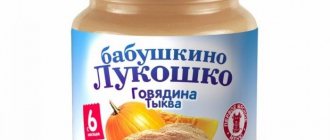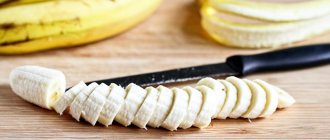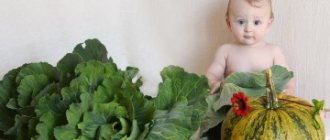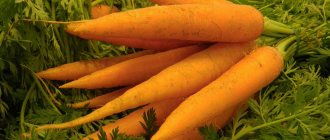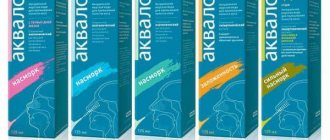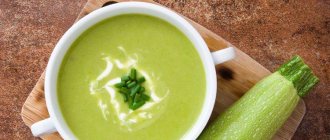Introducing a child to “real” food begins with the first feeding. First you need to decide which product to offer your baby without the risk of causing allergies or stomach upset.
The ideal food for a baby is mother's milk, which contains everything the baby needs for normal development. But six months or a little more time passes, and milk alone is no longer enough for the rapidly growing baby. This means that it’s time to introduce complementary foods - the first real food that will begin the little person’s acquaintance with “adult” foods. Some pediatricians advise starting with kefir, others recommend introducing baby food with zucchini or other vegetables.
When to start complementary feeding
According to the recommendations of the World Health Organization, breastfed children should be fed complementary foods from six months. If the mother’s nutrition is complete and there is enough milk, there is no point in introducing complementary foods earlier. Formula-fed babies are switched to vegetable purees from about 4 months. You can find out that your child is ready to receive complementary foods by the following signs:
- The child turns his head well and sits with support
- His weight doubled
- He opens his mouth when you offer a spoon and swallows the food rather than trying to spit it out.
If the baby has already reached six months of age, you should not start introducing baby food into the diet if:
- Vaccination has been carried out or will be carried out within two weeks
- The temperature has risen
- Upset stomach or other ailment
- The weather is hot
The question of when to start complementary feeding needs to be approached individually; girls and boys develop differently, and premature babies have their own characteristics.
Rules for introducing complementary feeding with pumpkin
Despite all the benefits of the vegetable, it, like all other new products, is introduced into the baby’s menu according to specially developed rules.
- The first portion is 3-5 g of homogeneous puree, or you can give a small, well-cooked piece the size of a grain of rice.
- A new product is introduced if the baby has not tried anything else over the last 2-3 days.
- Strictly one new product is introduced, otherwise it will be difficult to identify what caused the allergic reaction or interruptions in the gastrointestinal tract in the infant.
- It should be given in the first half of the day. Afterwards, during this day and the next two, observe the reaction of the baby’s body.
- If there is no negative reaction, the serving size is gradually increased to 40 g per day.
- In case of allergic manifestations or digestive disorders, feeding pumpkin should be postponed.
- It is not recommended to introduce complementary foods during illness or after vaccination.
At what age can it be administered?
From what months is it allowed to introduce pumpkin into complementary foods? Breastfeeding experts recommend giving your baby zucchini and cauliflower first. And only then, from seven months, begin to accustom him to pumpkin. The fact is that the bright color and pleasant taste will discourage the baby from eating neutral vegetables in the form of zucchini or cauliflower.
How often can you give pumpkin?
Where to start complementary feeding
Previously, pediatricians advised giving the child fruit juice - first apple, then pear, and so on. The purpose of juices is to prepare the baby’s stomach for foods other than breast milk. Problems began when children had to be switched from sweet juices to vegetable purees from zucchini, pumpkin, cauliflower or porridge. The stomach was ready to digest the new product, but most of the little ones categorically did not like the taste.
It is not difficult to accustom your baby to tasty juices, but they do not contain enough minerals. Recently, most pediatricians have been inclined to believe that it is better to start complementary feeding with pureed vegetables, for example, zucchini puree.
Recipes
And now it’s time to share recipes for zucchini dishes. Until a year, limit yourself mainly to purees and soup; after a year, the menu can be expanded.
Zucchini casserole with hard cheese
The tasty dish is quickly prepared, and can be eaten from one and a half years old. You will need:
- 2 small zucchini;
- 30 g finely grated cheese;
- 3 eggs, preferably homemade, make sure they are fresh.
Cut the washed and peeled vegetables into pieces up to 2.5 cm thick. Beat the eggs thoroughly. Grease a baking dish with sunflower oil, you can sprinkle it with breadcrumbs. Place zucchini on it in 1 layer, pour beaten eggs over everything, sprinkle cheese on top. Bake in a moderately preheated oven for 25 minutes. Pour sour cream over the finished dish. If desired, you can sprinkle with herbs - dill and parsley.
Stuffed zucchini
The filling is meat and rice. The dish turns out very tasty due to the saturation of the meat with vegetable juice. The minced meat comes out tender and incredibly flavorful. You will need the following products:
- half a glass of rice;
- 2–3 small zucchini;
- 300 g minced meat;
- greenery;
- minced meat, preferably veal, but beef can also be used - 300 g;
- small onions;
- half a glass of sour cream;
- salt - to taste.
First we prepare the filling. Cook the rice slightly so that it remains slightly firm. While cooking, peel the zucchini, cut it into 4-5 pieces (crosswise), remove the core, but not all the way, so that the “bottom” remains - you should get small glasses. Grind the extracted vegetable pulp using a blender, add onions and herbs to the mixture, then add cooked rice and salt. Stuff the zucchini and then bake it in the oven.
Creamy zucchini soup
This soup is indispensable in the summer. It cooks very quickly, children eat it with great pleasure and, of course, it is much tastier than traditional first courses with potatoes and cereals. You will need:
- one and a half glasses of milk;
- 2 small zucchini;
- greenery;
- a pinch of salt.
Vegetables or cereals?
It is impossible to answer this question unequivocally. If a child is behind in weight, it is advisable to feed him porridge. For babies who have constipation, vegetables are more suitable.
Feeding children who are indicated for purees should begin with tender vegetables without a pronounced taste or smell. Typically, pediatricians recommend choosing between zucchini, carrots, pumpkin and broccoli.
The first portions of complementary foods should be minimal. Half a teaspoon of vegetable puree and breast milk. Observe your child during the day to see if there is a rash or if the stool is normal.
Pumpkin puree recipe
There are many recipes for baby pumpkin puree. Pumpkin is especially popular in combination with apples, carrots, pears and some types of cereals. Below are the best recipes loved by babies under one year of age.
Simple pumpkin puree
Take the pumpkin and remove the seeds and skin. Cut the orange pulp into small cubes and boil in boiling water until tender for half an hour. The finished vegetable should be soft and easy to crush.
If you decide to cook the pumpkin in a double boiler or slow cooker, the cooking time will increase to 1 hour.
Cool the boiled vegetable (but do not refrigerate) and blend in a blender until smooth. You can also add the following ingredients to the puree:
- breast milk or a spoonful of formula;
- egg yolk;
- olive oil;
- butter.
Scheme for introducing vegetable complementary foods
Children respond best to vegetable puree made from zucchini. If on the first day there were no unpleasant symptoms, increase the portion to a whole teaspoon, on the third day - to two spoons. It will take two weeks to introduce a new product, during which time the baby will get used to the new food and the next ingredient can be added, for example, cauliflower. The scheme is repeated: add half a teaspoon to the usual portion and dilute with breast milk. Gradually increase the share of the new product at the expense of the already familiar one.
Helpful Tips:
- Heat the puree to 40°C in a steam bath or in warm water. You should not heat the entire jar of baby food for 1-2 spoons - put the required amount of puree in a glass container. Scientists do not confirm rumors about the dangers of microwaves, but pediatricians never recommend this heating method.
- Give solids at the same time in the morning to monitor your baby's response throughout the day.
- Feed your child vegetable puree from zucchini from a spoon - this will release saliva in the mouth, which is necessary for absorption.
- Gradually, mashed potatoes and porridge will replace mother’s milk from the diet; after introducing meat and fish into the diet, squash puree will be a side dish.
- Complementary foods should be given before breastfeeding.
How to make puree
In order for a children's zucchini dish to be tasty and healthy, it is worth considering the following nuances:
- before cooking purchased zucchini, they must first be soaked in lightly salted water in order to get rid of harmful chemicals;
- the stem, as well as the lower and upper ends of the vegetable, are cut off (usually a large concentration of nitrates accumulates in them);
- for the first feeding, the skin of the zucchini is removed (it can be left for older children, because the skin contains many vitamins);
- The utensils for preparing puree must be thoroughly washed and treated with boiling water.
Basic puree recipe
- cut the washed, peeled vegetable into thin rings, remove all seeds;
- place the zucchini in a pan of boiling water;
- in 7-12 minutes the vegetable will be ready (you cannot digest it, as it will become absolutely tasteless and also lose its beneficial properties);
- Grind the cooled zucchini using a blender;
- You can add 1 drop of olive oil or a little breast milk to the finished puree.
Cooking in a slow cooker
- wash, peel and chop vegetables;
- Place the pieces in a multicooker bowl, pour in filtered or special baby water so that the vegetable is completely covered;
- set the “quenching” mode for 10 minutes;
- At the end of cooking, chop the vegetable until smooth.
If the zucchini puree is too thick, you need to dilute it with the broth in which it was cooked.
You can store the finished puree in the freezer for 3 months, however, this is still not recommended. It is better to freeze fresh vegetables in small containers or bags in advance and cook a portion of puree each time.
Zucchini is an ideal product for a baby who is just starting to eat anything other than breast milk or formula. The airy and healthy puree from this crop rarely causes negative reactions in a child and serves as an excellent basis for the subsequent expansion of the diet. Young mothers will also appreciate the dish - it is easy and quick to prepare.
The question of starting complementary feeding is one of the most exciting for a young mother. A change in the existing diet, possible difficulties that await the baby on the difficult path of transition to adult food, debates about which product is better to introduce first - all this must be studied before offering the baby his first spoonful of complementary foods. Most modern young mothers give priority to introducing vegetables into their baby’s diet. Pediatricians share the same opinion. Let's consider the features of using the most popular vegetable in this sense - zucchini - as a first complementary food: what is the basis for the choice of this product, what beneficial properties does this vegetable have, how to make zucchini puree yourself and which industrial puree is better to choose.
Why zucchini
This early vegetable does not have a distinct taste or smell, but it contains useful substances and delicate fiber. The composition of zucchini is approximately this:
- 93% water
- 0.5% protein
- 6% carbohydrates
- less than 0.1% fat
100 g of vegetable contains only 20 kcal, which means that eating puree will not affect the child’s weight in any way. Nutritionists and pediatricians believe that the balance of carbohydrates, proteins, microelements and vitamins in this case is ideal; unripe zucchini is especially useful. Manufacturers of baby food take this into account, as well as the fact that the fruits contain:
- B vitamins
- Useful acids: nicotinic, folic and ascorbic
- Set of microelements
The delicate texture of young zucchini and beneficial substances make zucchini one of the best complementary feeding options for little ones.
Vegetable purees from zucchini are useful in a child’s diet, they are:
- Strengthen immunity
- Stimulates enzyme production
- Normalizes intestinal motility
- Promote hematopoiesis and development of the nervous system
Zucchini is easily digestible, does not cause allergies, does not irritate the mucous membranes and gently helps to cope with constipation. It is important that fiber creates a favorable environment for the development of the necessary microflora, which prevents dysbacteriosis.
Pediatricians are confident that you need to start complementary feeding with foods typical for your region of residence. From this point of view, zucchini and food for children with the addition of this vegetable are ideal.
What are the benefits of pumpkin for babies?
The beneficial qualities of this fruit are due to its chemical composition. The vegetable is perfectly digestible, promotes digestion and is rich in the following elements:
- Vitamin A is important for vision, bone formation, affects the condition of the skin, and activates regeneration.
- Vitamin E is responsible for metabolic processes, promotes the absorption of vitamin A, and is a powerful antioxidant.
- Vitamin C strengthens the immune system, is recognized as an antioxidant, and is involved in hematopoiesis.
- Vitamin B1 is involved in metabolic processes and strengthens the nervous system. B2 – promotes protein absorption.
- Vitamin K improves blood clotting and prevents the development of osteoporosis.
- Vitamin D is involved in cell division and is important for the quality of teeth and bones.
- Calcium affects the condition of teeth and bones, and is involved in blood clotting processes.
- Magnesium helps form muscle cells and is important for teeth.
- Iron is involved in hematopoiesis, strengthens the body’s protective functions, and stimulates the absorption of B vitamins.
- Zinc is involved in the formation of bone tissue.
- Pectins help remove harmful substances, and fiber normalizes intestinal function.
Is an allergy possible?
Pumpkin fruits contain carotene, which can cause allergies or lead to “carotene jaundice.” If complementary foods are introduced according to all the rules and allergic manifestations are detected in the baby, eating pumpkin should be postponed. Allergies manifest themselves as:
- redness on the skin;
- itching;
- rash;
- runny nose or cough.
Home cooking or jarred zucchini puree
Zucchini puree prepared with your own hands will certainly be tastier than factory-made, and the content of nutrients in it will also be preserved. But WHO insists that the first complementary foods should be industrially produced. Even with strict adherence to purity and recipes, you cannot be sure that the zucchini purchased at the market or in a store was grown in environmentally friendly conditions and without the use of chemicals and fertilizers.
Canned puree is homogenized, that is, in industrial production it is possible to achieve its complete homogeneity without separation into juice and pulp. This can be achieved through repeated mixing, which is difficult to do at home. This is the consistency that is suitable for the first portions of complementary foods, which should not differ sharply from breast milk. When you open the jar for the first time, you may be surprised by how liquid the puree is, but it is easier for your baby to swallow such food than a thick mass.
At the enterprise, baby puree is prepared in vacuum devices, evaporating moisture at temperatures up to 100°C. With this mode, beneficial substances are preserved as much as possible.
Storing zucchini
Zucchini needs to be eaten quickly, they do not last long and preferably in the refrigerator. If stored properly, mature zucchini will not spoil within 4-5 months. If stored for a longer period of time, vegetables may become overripe or spoiled. Therefore, it is better to make canned caviar for the whole family or freeze them raw in pieces. Zucchini frozen for the winter will be just as beneficial for babies as fresh ones.
How to properly freeze zucchini for feeding a baby so that their beneficial properties are not lost? First you need to peel and cut the vegetables. Place the chopped zucchini in a clean container or bag and place in the freezer.
How to choose the perfect jarred puree
The selection of jarred purees in baby food stores is huge. There are always a dozen jars from different manufacturers on the shelves. It is difficult to guess which product is trustworthy the first time; focusing on the tastes of friends is also not always correct. You should not consider your own preferences, but choose a product that your child will like.
- The first thing you need to pay attention to is single-component. There should only be zucchini in the jar.
- The presence of additives - salt, sugar, starch, etc. - is unacceptable.
- On each jar the manufacturer indicates the age of the child for whom the food is intended. Please consider these recommendations.
The benefits and harms of pumpkin for children
It is not in vain that pumpkin is one of the first to be introduced into baby food. It contains vitamins and a record amount of mineral elements necessary for a small organism.
Useful qualities of pumpkin for kids of different ages:
- Vitamins A, B, C, D, E, PP, as well as rare K and T - improve vision and functioning of the nervous system, strengthen the bone elements of the skeleton, teeth and provide high immunity.
- Potassium and magnesium in the composition improve the functioning of the cardiovascular system, have a mild diuretic effect, preventing the appearance of edema.
- Effectively fights inflammatory processes and inhibits their development.
- Pumpkin contains plant fiber, so it is useful for a baby suffering from frequent constipation and digestive disorders.
- Pumpkin pulp is useful for baby food, as it accelerates the removal of harmful waste and toxins from the body.
- This dish is indispensable if the baby suffers from sleep disorders. It calms, improves memory and thinking.
- Eating pumpkin dishes is recommended to improve the functioning of the liver, gall bladder and ducts.
- Improves skin condition, helps fight dermatitis and various rashes.
- Normalizes cholesterol and hemoglobin levels in the blood, preventing the development of anemia.
- The beneficial properties of pumpkin for children include increasing overall tone and activity, and slowing down premature aging of cells.
When answering at what age a child can start giving pumpkin, pediatricians emphasize that there are a number of contraindications to this product. It is not allowed to be eaten if you have intestinal colic, diabetes mellitus and hepatitis, gastritis and stomach ulcers, as well as other diseases of the digestive system.
Despite all the usefulness of pumpkin, it is very important to monitor the size of complementary foods and its compliance with age standards. Too large portions can lead to a yellowish tint to the skin (due to the large amount of beta-carotene), disturbances in the digestive system, and stool upset.
Assortment of zucchini baby food
Almost all manufacturers produce canned zucchini puree. We did some research on the samples. Strict control is carried out at enterprises, the recipe has been thoroughly tested, the quality of all products is decent, many companies use only independently grown vegetables.
Zucchini puree without additives:
| Manufacturer | Age | Description |
| "Spelenok" | (4 months) | Produced in Russia, packaged in glass jars and tetrapacks. Zucchini is grown specially at the Pridonya Gardens farm. Delicate taste, pleasant consistency. |
| "Granny's Basket" | (4 months) | Produced by Russian. Glass 100 gram jars, high quality puree. |
| "Bambolina" | (4.5 months) | The Belarusian manufacturer prepares puree from specially grown vegetables and enriches it with ascorbic acid. Food in glass jars. |
| "Abibok" | (4 months) | Another manufacturer from Belarus produces puree without additives. Glass jars with a capacity of 100 and 190 g. |
| "Semper" | (4 months) | Jars of tender zucchini puree made in Sweden. A quality product for first feeding. |
| "Gerber®" ("Nestle") | (4 months) | Most kids like Swiss or Polish puree. The liquid consistency allows the child to get used to the new food. No genetically modified zucchini, preservatives, dyes, starch, sugar or other additives are used in production - only zucchini and water. |
Review of industrially produced monocomponent zucchini purees
Almost every popular brand of baby food has mono-component zucchini puree in its product range. Let's compare several popular options in the table.
Table: comparative characteristics of canned zucchini puree
| Name | Compound | Weight | Shelf life | approximate cost |
| Hipp |
| 80 g | 18 months | 50–60 rub. |
| Heinz |
| 80 g | 24 months | 40–50 rub. |
| Beech nut |
| 71 or 113 g | Before the date indicated on the package | 45–50 rub. |
| "Granny's Basket" | Zucchini puree | 100 g | 24 months | 40–45 rub. |
| "Spelenok" | Zucchini puree | 80 g | 12 months | 30–35 rub. |
| "Subject" |
| 125 g | 24 months | 30–35 rub. |
Due to differences in raw materials and composition, the taste of the product varies greatly from manufacturer to manufacturer.
Photo gallery: monocomponent zucchini purees
Zucchini puree with additives
When the child gets used to zucchini puree, you can move on to baby food with several vegetables or with the addition of fruits and milk.
| Manufacturer | Description |
| "Gerber" | This baby food is available in several versions: sauté with potatoes and cauliflower, salad with carrots, potatoes and cauliflower or with broccoli, apple and milk. |
| "Hipp" | German food of zucchini, potatoes and rice. The composition includes rapeseed oil, rich in Omega-3 and -6 fatty acids. |
| "Bebivita" | Country of origin: Germany. In 100 gram glass jars, the squash is thickened with rice flour and supplemented with corn oil. |
| "Semper" | In Sweden they produce zucchini puree with potato flakes and olive oil. Glass jars contain 125 grams of food for children after 4 months. |
| "Nestle" | Swiss quality from a famous manufacturer guarantees complete nutrition for children over 8 months. Ingredients: zucchini, potatoes, rice flour, spinach, parsley, vegetable oil. |
| "Granny's Basket" | The domestic manufacturer offers several options for squash puree with apples, carrots, wheat flour or milk. |
| "FrutoNyanya" | This food, intended for children from five months to three years, is made in Russia. Ingredients: zucchini and cauliflower, broccoli or potatoes. |
Not all children are ready to immediately fall in love with baby zucchini puree. A child may outright refuse a new food not because he doesn’t like zucchini - it just takes time to get used to the unfamiliar taste. Sometimes you have to repeat attempts 10-15 times until the baby agrees to eat from a spoon. Be patient and attentive to the child's health.
Click Share and make your friends happy!
When and how to introduce complementary foods
According to WHO recommendations, it is not advisable to introduce any complementary foods before 6 months - breast milk is enough for the baby.
However, for children who are bottle-fed, mixed-fed, or underweight, the pediatrician may recommend trying food a little earlier. When offering zucchini puree to your baby, you should adhere to the following rules:
- Do not insist on eating when the child is sick, upset or sleepy.
- Postpone the introduction of the dish if you are planning a trip, visit or vaccination.
- The first time the baby is given a minimum dose of puree - half a teaspoon, then he is supplemented with breastfeeding or formula.
- The puree must be exclusively one-component, and also not contain additives in the form of salt or sugar.
- It is better to offer the dish in the daytime (around 12.00) before one of the breast or formula feedings.
- The puree should be freshly prepared and warm.
- During the day, it is necessary to carefully monitor the child’s reaction: changes in behavior, temperature, skin (rash, red spots), stool. In the absence of negative reactions, you can continue introducing zucchini into complementary foods, gradually increasing it to the age norm (6 months - up to 100 g, 7-9 months - up to 150 g, 10-12 months - up to 200 g).
An approximate scheme for introducing zucchini into a child’s complementary foods is as follows:
- 1 day - 2.5 g (0.5 tsp);
- Day 2 - 5 g (1 tsp);
- Day 3 - 15 g (3 tsp);
- Day 4 - 35 g (7 tsp);
- Day 5 - 50 g (10 tsp);
- Day 6 - 70 g (14 tsp);
- Day 7 - 100 g (20 tsp).
If a child refuses to eat zucchini, you cannot force puree into him or distract him with cartoons or conversations. Put off complementary foods for a while. Perhaps the baby is tired, wants to sleep, or has a stomach ache. And it also happens that he may not like the taste of zucchini. In this case, it can be replaced with another vegetable - cauliflower, broccoli.
We select and prepare correctly
Is there a safer way to introduce zucchini into complementary foods, like making your own puree from your own vegetables from the garden. But if the child was born in the summer, the time for complementary feeding will most likely fall in the winter season, when fresh vegetables can only be obtained imported in the supermarket. Imported products may contain high doses of nitrates and other harmful substances. You can get out of this situation in the following ways.
- Prepare ahead of time. Young green (including greenhouse) fruits no more than 20 cm long are suitable for freezing or pureeing for the winter. Their flesh is tender, pliable, and it is easy to remove the seeds from such vegetables. They should be smooth, resilient, slightly shiny, free of scratches and stains, and from a supplier you trust.
- Buy puree in jars. Here it is important to pay attention not to the manufacturer (factory products are certified in any case), but to what ingredients he uses. It is best if baby food contains only zucchini and water. “Pear-shaped zucchini” in puree is almost the same as pumpkin, and at the beginning of complementary feeding it is better to avoid it due to the high risk of allergies. It is not necessary at first and mix it with the most familiar food for the baby.
Zucchini does not go well with milk, and there should be an interval of at least 6 hours between these products on the baby’s menu. But this vegetable goes well with protein (meat), fats (a small amount of olive oil), other vegetables and herbs.
Frozen is good too
Fresh young zucchini is not stored for long, as they have a porous thin skin and a lot of water. And ripe large fruits with thick skin, although they can be stored since summer, have a coarser texture and less nutritional value for a child. This is why it is better to freeze young vegetables.
- Wash the fruits thoroughly, cut off the skin in a thin layer.
- Remove the small “cap” from the end of the fruit, and the stalk from the other end (there may be accumulations of nitrates here).
- Cut the vegetable into 3 cm thick slices (without removing the core), place in a freezer bag in one layer.
When frozen, both mineral salts and vitamins are perfectly preserved. Frozen pieces of vegetables should be cooked without defrosting, but immediately by placing them in boiling water or a double boiler. The puree will be slightly watery, but no less healthy than from a fresh product.
Useful properties of zucchini
Why is this vegetable often called the best option for introducing complementary foods? It’s very simple: it’s easy to prepare, it tastes good, it usually doesn’t cause allergic reactions (we’ll talk about them later), and thanks to the presence of a huge amount of useful substances, it improves health. In particular, it can even be used to cope with physiological anemia, which can occur in children under the age of 1 year.
Zucchini is a melon plant, a type of pumpkin, but it contains many more minerals, twice as much vitamin C and much less sugars (which can negatively affect the pancreas and stomach lining).
Here are just some of the advantages of this vegetable.
- A little fiber, a lot of water. The stomach is not irritated, the intestines are not overloaded with coarse dietary fiber - on the contrary, its work (peristalsis) is gently enhanced, making the product easily digestible.
- The potassium content in relation to sodium is 100:1. This is the optimal ratio for the body, maintaining and regulating water balance. Consequently, the heart rate normalizes, muscles and nerve cells work well, and oxygen supply to the brain improves. Excess water is removed from the body, and along with it, harmful substances.
- A storehouse of mineral salts. In addition to the above elements, there is a high content of magnesium, phosphorus, calcium, copper, and iron.
- There are only 27 kilocalories per 100 g of zucchini. This makes it possible to recommend healthy eating to children with a tendency to gain weight.
